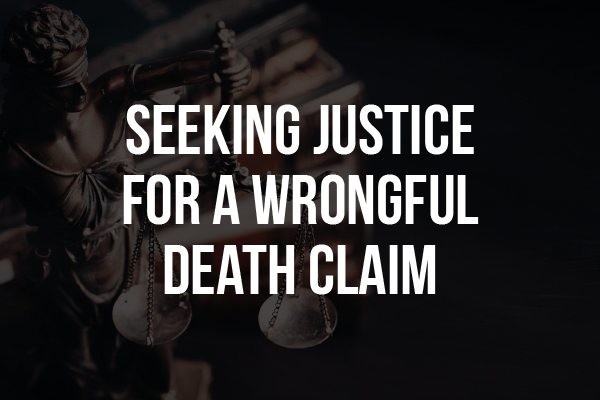
Death is a natural part of life. But when a loved one is taken from you out of the blue, and the negligent actions of another person caused their death, you want justice for your pain and suffering. Texas State law allows surviving family members to file a wrongful death claim so they can seek financial compensation for losses and damages caused by the liable party. While the compensation can never replace the individual lost in the accident, it does allow the family to get much-needed relief from the financial burden that comes with the loss of a family member—as well as a sense of justice.
If you have recently lost a loved one due to the negligent or intentional actions of another individual, don’t lose hope. A knowledgeable and experienced wrongful death attorney can help you claim the compensation you deserve. In this article, our team goes over how to file a wrongful death claim in Abilene, Texas, and what the process looks like. If you have any questions or concerns, our team is more than happy to sit down and talk with you. Here is what you need to know:
What Is a Wrongful Death in the State of Texas?
The Texas Civil Practice and Remedies Code defines wrongful death as the loss of life due to another individual’s negligence, wrongful act, recklessness, carelessness, or intentional conduct. A wrongful death claim can be brought against the defendant if the deceased would have been eligible to file against the negligent party had they survived the incident.
What Are the Elements of a Wrongful Death Claim?
The plaintiff must prove four elements to a wrongful death claim in order for them to get compensation. The elements are similar to those that must be established for personal injury claims in the state of Texas. They are as follows:
Element 1: The Defendant Had a Duty to the Victim:
The first element that must be proven is that the defendant owed a duty of care to the individual who passed. For example, all drivers have a duty of care to follow the traffic safety laws and regulations set in place to keep individuals safe while on the road.
Element 2: The Defendant Breached Their Duty of Care
To prove that there was a breach of duty, it must be proven that the defendant failed to behave with the level of care that a reasonable person would have in a similar situation. For instance, let’s say that a driver was approaching a red light. They have a duty to stop at the red light and wait for it to turn green before passing through the intersection. If the driver was on their phone, not paying attention to their surroundings, and failed to notice that the light turned red and plowed through the intersection, they breached their duty of care.
Element 3: The Breach of Duty Was the Direct Cause of the Wrongful Death

If the driver from the example before went through the intersection, despite the red light telling them to stop, and hit another vehicle, their breach of duty was the direct cause of the accident. In a wrongful death case, it must be proven that the victim died as a direct result of the accident and not due to a pre-existing condition or something that happened afterward.
For example, let’s say that the defendant who went through the intersection smashed into the driver-side of a car turning through the intersection. The victim suffered horrific injuries and was rushed to the hospital. That victim ultimately succumbed to their injuries due to the accident. In this case, the driver who ran through the red light would be considered responsible, as it was their actions that caused the accident and the injuries.
Now, let’s say that the victim had a pre-existing brain aneurysm and it was the brain aneurysm that happened to take the victim, not the injuries they received due to the accident. In this case, unless the accident aggravated the brain aneurysm, it was a pre-existing condition that took the victim and not the injuries suffered due to the accident.
Element 4: There Were Damages Due to the Loss of the Victim
In cases of wrongful death, it must be proven that the defendant’s actions caused pain, suffering and financial damages to the loved ones of the deceased. These damages often include the loss of financial support or companionship.
Who Is Legally Able to File a Wrongful Death Claim in Abilene, Texas?
Many people may legitimately feel the pain of losing a loved one, but only a handful are legally allowed to file a wrongful death suit. This includes the deceased’s surviving spouse, children, or parents.
If there are no surviving relatives who can file a lawsuit within three months of the death, the representative of the estate may file a claim instead. The Statute of Limitations for Wrongful Death gives loved ones or the estate, depending on the circumstance, two years to file the claim after the loss.
How Do I Prove the Elements of a Wrongful Death Claim?

The best way to prove the elements of a wrongful death claim is to keep an accurate record of the events leading up to, during, and immediately after the accident. These records include but are not limited to the following:
- Accident reports
- Medical records
- Autopsy reports
- Witness testimony
Trying to gather this information may seem impossible while you’re grieving your loved one, but remember that you’re not alone. Having a dedicated and passionate wrongful death attorney on your side can help you get through the process and put you and your family on the road to recovery. Don’t think you have to handle the journey alone.
The Team At the Hernandez Law Group Can Help
If your loved one has perished due to the negligence or intentional actions of another individual, you need an experienced hand to guide you through the legal process. The team at the Hernandez Law Group, P.C. has been serving Abilene, Texas since 1999. We fight hard to ensure that your family gets the compensation you deserve to aid on the road to recovery. We have recovered hundreds of millions of dollars for our clients, and have a 98% success rate. Contact our team today for more information on our services or to schedule a free no-obligation consultation with us.
